Developing an Action Plan for Enhancing Communication Skills
VerifiedAdded on 2020/05/16
|24
|4786
|58
AI Summary
The assignment involves creating a comprehensive action plan aimed at enhancing communication skills. The core objective is to equip individuals, particularly graduates, with the necessary tools and strategies to effectively communicate in both personal and professional settings. It draws upon various theoretical frameworks and practical approaches from existing literature on communication models and interpersonal dynamics. Key components include setting clear objectives for skill development, identifying critical areas needing improvement, and implementing tailored strategies such as non-verbal immediacy techniques and tolerance for disagreement exercises. The plan also emphasizes continuous evaluation through feedback mechanisms to ensure ongoing progress and adaptation. This structured approach is designed to enhance graduates' employability by focusing on essential soft skills required in today's competitive job market.
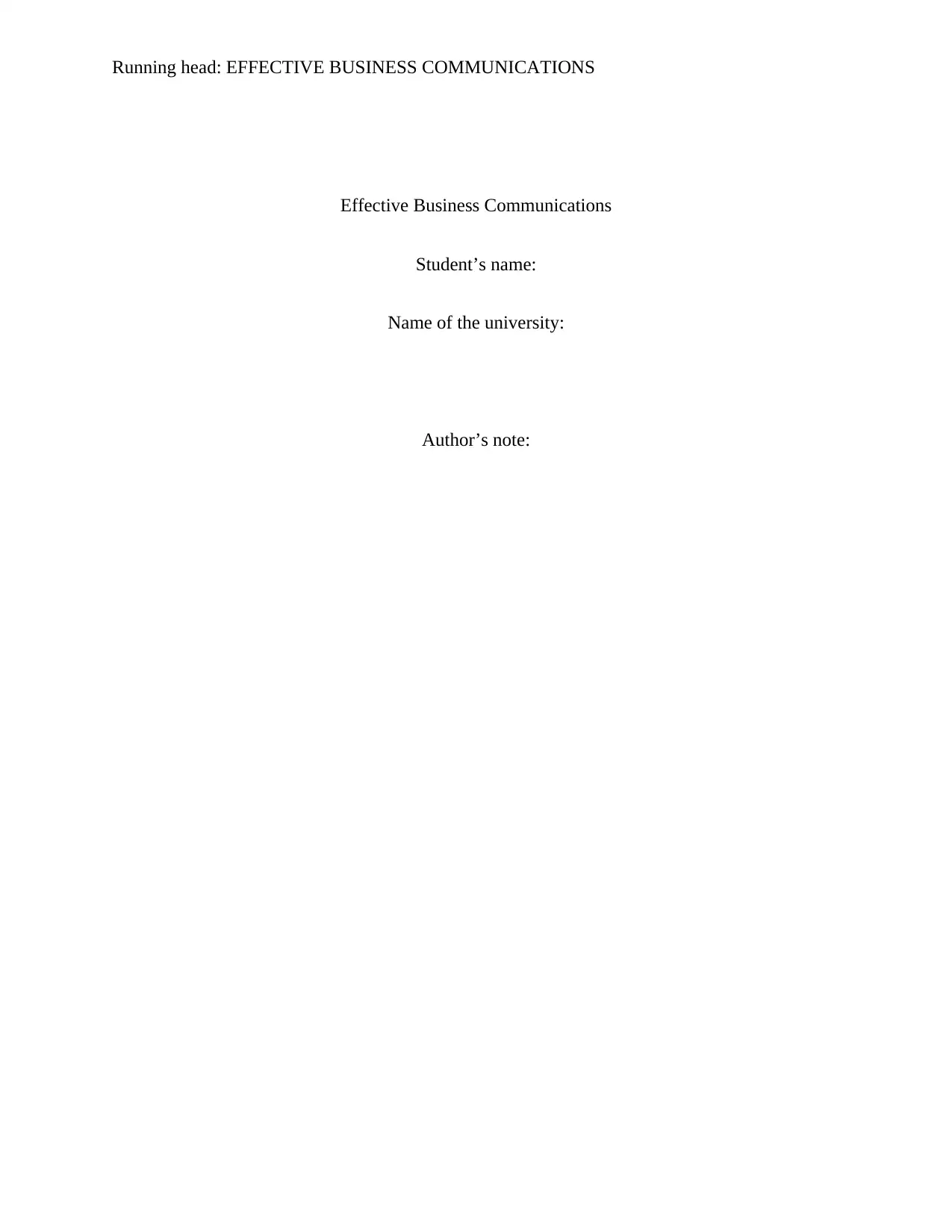
Running head: EFFECTIVE BUSINESS COMMUNICATIONS
Effective Business Communications
Student’s name:
Name of the university:
Author’s note:
Effective Business Communications
Student’s name:
Name of the university:
Author’s note:
Paraphrase This Document
Need a fresh take? Get an instant paraphrase of this document with our AI Paraphraser
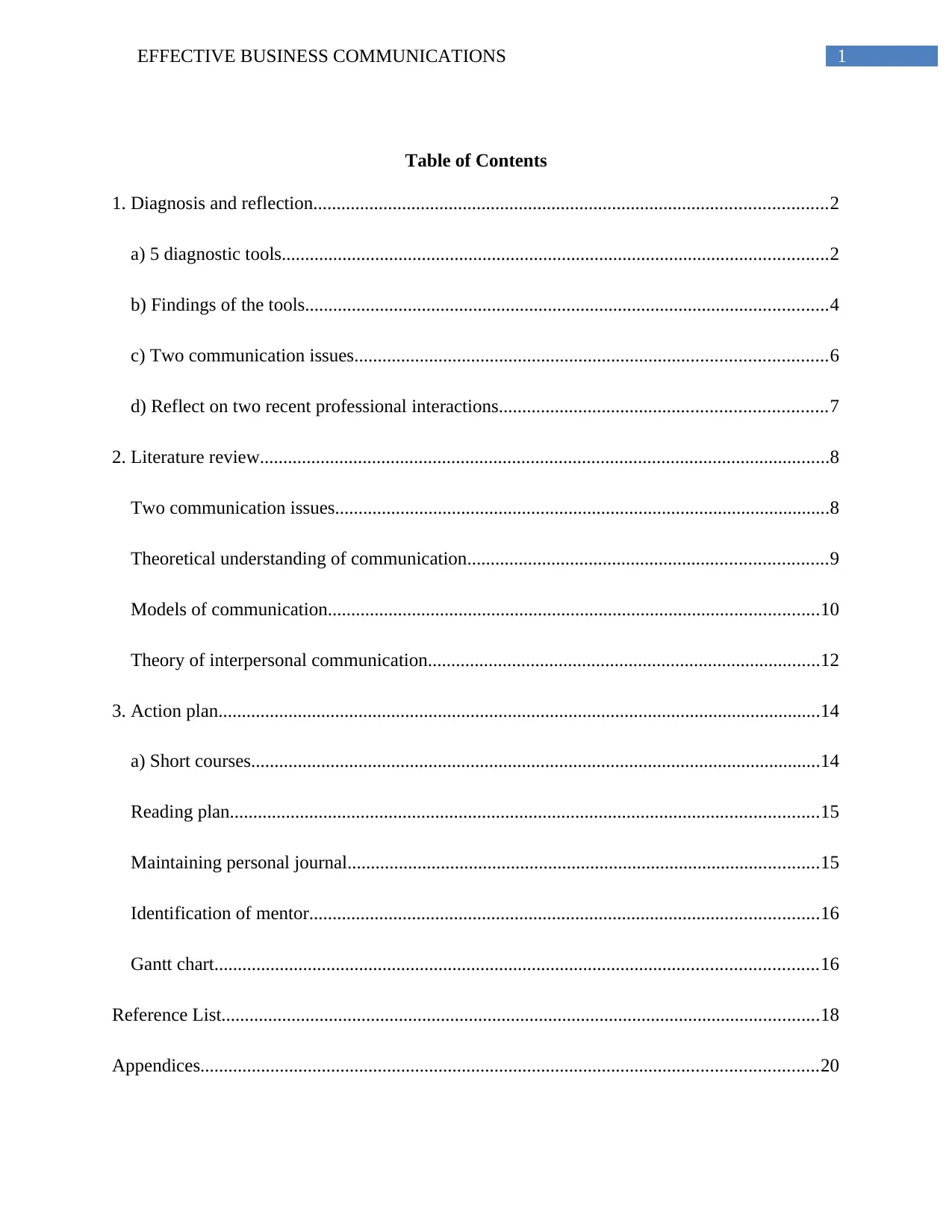
1EFFECTIVE BUSINESS COMMUNICATIONS
Table of Contents
1. Diagnosis and reflection..............................................................................................................2
a) 5 diagnostic tools.....................................................................................................................2
b) Findings of the tools................................................................................................................4
c) Two communication issues.....................................................................................................6
d) Reflect on two recent professional interactions......................................................................7
2. Literature review..........................................................................................................................8
Two communication issues..........................................................................................................8
Theoretical understanding of communication.............................................................................9
Models of communication.........................................................................................................10
Theory of interpersonal communication....................................................................................12
3. Action plan.................................................................................................................................14
a) Short courses..........................................................................................................................14
Reading plan..............................................................................................................................15
Maintaining personal journal.....................................................................................................15
Identification of mentor.............................................................................................................16
Gantt chart.................................................................................................................................16
Reference List................................................................................................................................18
Appendices....................................................................................................................................20
Table of Contents
1. Diagnosis and reflection..............................................................................................................2
a) 5 diagnostic tools.....................................................................................................................2
b) Findings of the tools................................................................................................................4
c) Two communication issues.....................................................................................................6
d) Reflect on two recent professional interactions......................................................................7
2. Literature review..........................................................................................................................8
Two communication issues..........................................................................................................8
Theoretical understanding of communication.............................................................................9
Models of communication.........................................................................................................10
Theory of interpersonal communication....................................................................................12
3. Action plan.................................................................................................................................14
a) Short courses..........................................................................................................................14
Reading plan..............................................................................................................................15
Maintaining personal journal.....................................................................................................15
Identification of mentor.............................................................................................................16
Gantt chart.................................................................................................................................16
Reference List................................................................................................................................18
Appendices....................................................................................................................................20
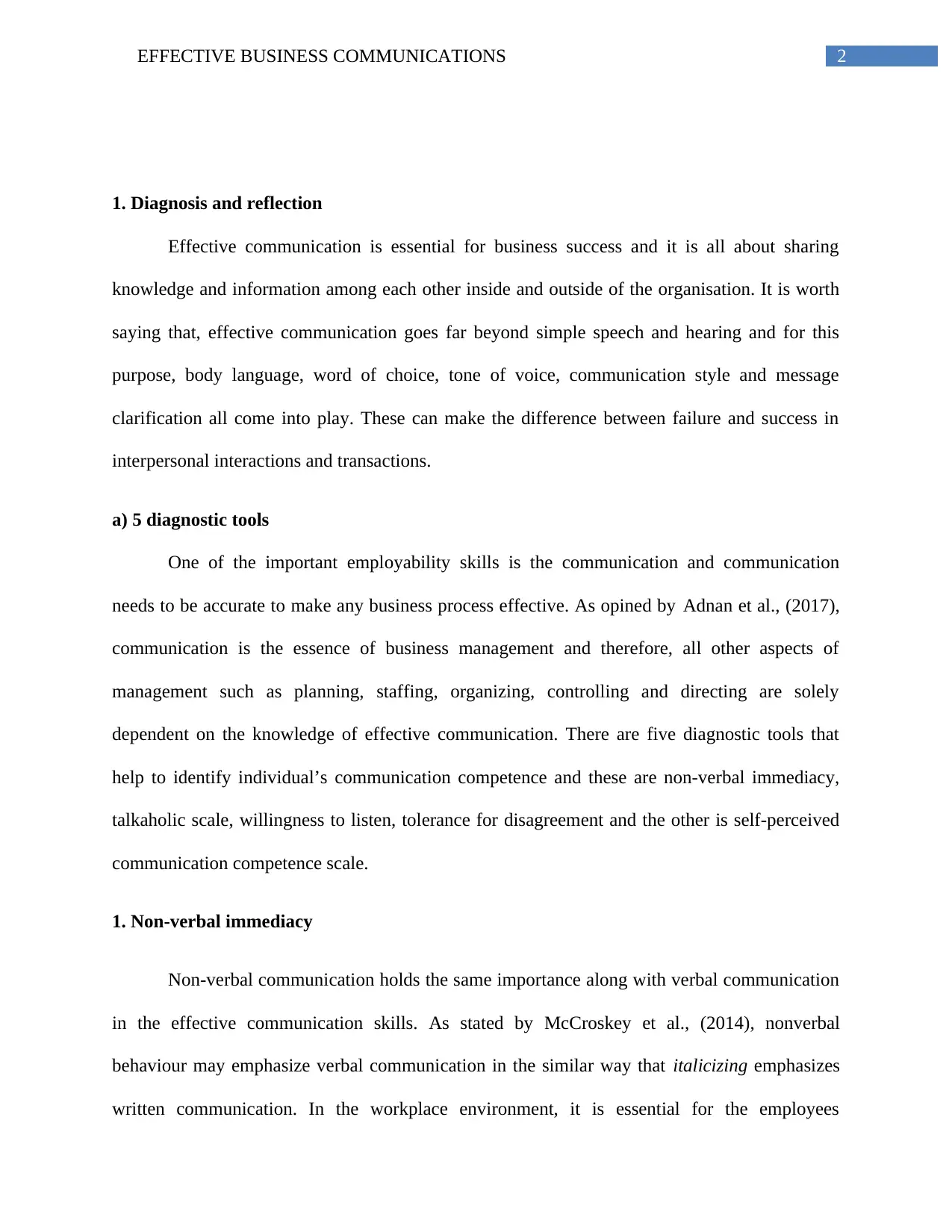
2EFFECTIVE BUSINESS COMMUNICATIONS
1. Diagnosis and reflection
Effective communication is essential for business success and it is all about sharing
knowledge and information among each other inside and outside of the organisation. It is worth
saying that, effective communication goes far beyond simple speech and hearing and for this
purpose, body language, word of choice, tone of voice, communication style and message
clarification all come into play. These can make the difference between failure and success in
interpersonal interactions and transactions.
a) 5 diagnostic tools
One of the important employability skills is the communication and communication
needs to be accurate to make any business process effective. As opined by Adnan et al., (2017),
communication is the essence of business management and therefore, all other aspects of
management such as planning, staffing, organizing, controlling and directing are solely
dependent on the knowledge of effective communication. There are five diagnostic tools that
help to identify individual’s communication competence and these are non-verbal immediacy,
talkaholic scale, willingness to listen, tolerance for disagreement and the other is self-perceived
communication competence scale.
1. Non-verbal immediacy
Non-verbal communication holds the same importance along with verbal communication
in the effective communication skills. As stated by McCroskey et al., (2014), nonverbal
behaviour may emphasize verbal communication in the similar way that italicizing emphasizes
written communication. In the workplace environment, it is essential for the employees
1. Diagnosis and reflection
Effective communication is essential for business success and it is all about sharing
knowledge and information among each other inside and outside of the organisation. It is worth
saying that, effective communication goes far beyond simple speech and hearing and for this
purpose, body language, word of choice, tone of voice, communication style and message
clarification all come into play. These can make the difference between failure and success in
interpersonal interactions and transactions.
a) 5 diagnostic tools
One of the important employability skills is the communication and communication
needs to be accurate to make any business process effective. As opined by Adnan et al., (2017),
communication is the essence of business management and therefore, all other aspects of
management such as planning, staffing, organizing, controlling and directing are solely
dependent on the knowledge of effective communication. There are five diagnostic tools that
help to identify individual’s communication competence and these are non-verbal immediacy,
talkaholic scale, willingness to listen, tolerance for disagreement and the other is self-perceived
communication competence scale.
1. Non-verbal immediacy
Non-verbal communication holds the same importance along with verbal communication
in the effective communication skills. As stated by McCroskey et al., (2014), nonverbal
behaviour may emphasize verbal communication in the similar way that italicizing emphasizes
written communication. In the workplace environment, it is essential for the employees
⊘ This is a preview!⊘
Do you want full access?
Subscribe today to unlock all pages.

Trusted by 1+ million students worldwide
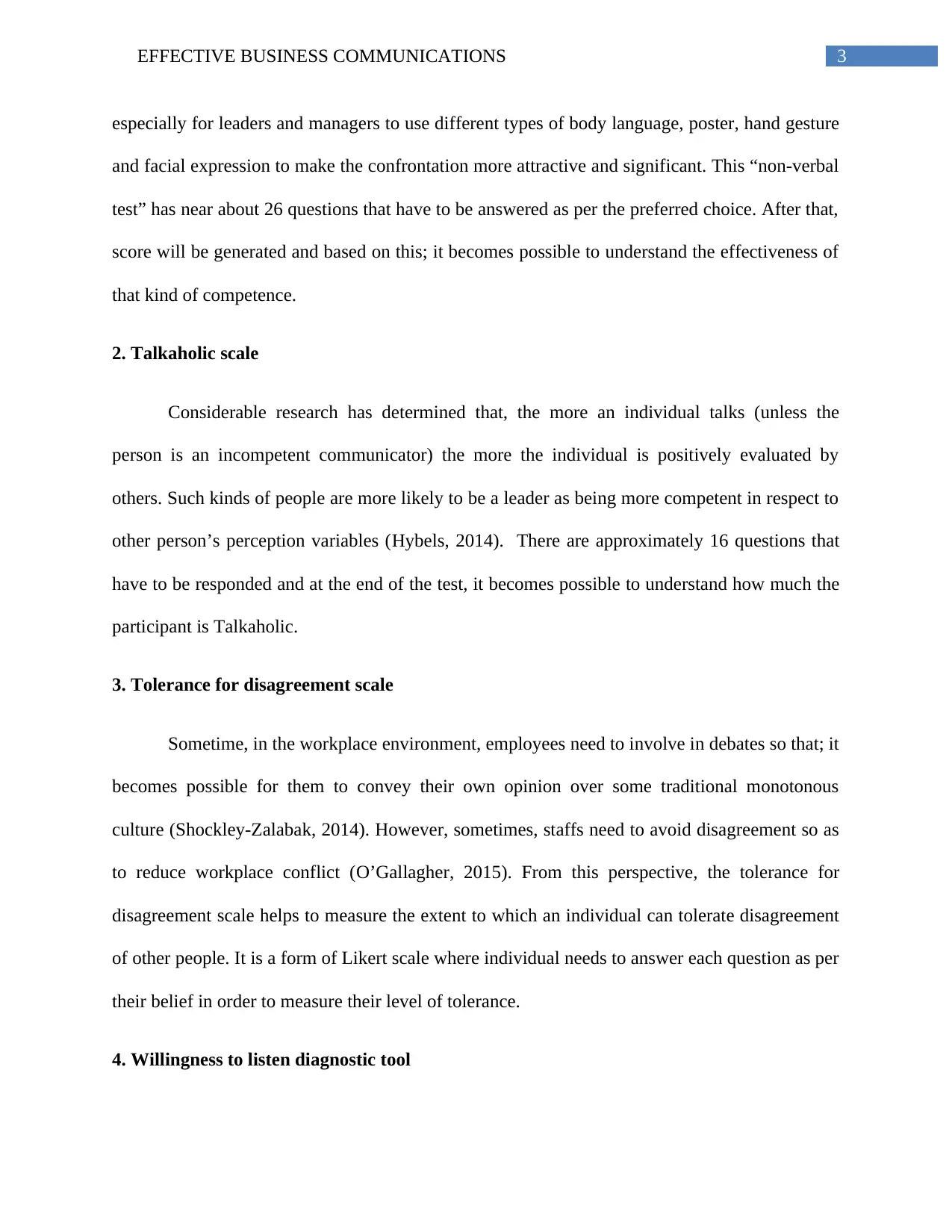
3EFFECTIVE BUSINESS COMMUNICATIONS
especially for leaders and managers to use different types of body language, poster, hand gesture
and facial expression to make the confrontation more attractive and significant. This “non-verbal
test” has near about 26 questions that have to be answered as per the preferred choice. After that,
score will be generated and based on this; it becomes possible to understand the effectiveness of
that kind of competence.
2. Talkaholic scale
Considerable research has determined that, the more an individual talks (unless the
person is an incompetent communicator) the more the individual is positively evaluated by
others. Such kinds of people are more likely to be a leader as being more competent in respect to
other person’s perception variables (Hybels, 2014). There are approximately 16 questions that
have to be responded and at the end of the test, it becomes possible to understand how much the
participant is Talkaholic.
3. Tolerance for disagreement scale
Sometime, in the workplace environment, employees need to involve in debates so that; it
becomes possible for them to convey their own opinion over some traditional monotonous
culture (Shockley-Zalabak, 2014). However, sometimes, staffs need to avoid disagreement so as
to reduce workplace conflict (O’Gallagher, 2015). From this perspective, the tolerance for
disagreement scale helps to measure the extent to which an individual can tolerate disagreement
of other people. It is a form of Likert scale where individual needs to answer each question as per
their belief in order to measure their level of tolerance.
4. Willingness to listen diagnostic tool
especially for leaders and managers to use different types of body language, poster, hand gesture
and facial expression to make the confrontation more attractive and significant. This “non-verbal
test” has near about 26 questions that have to be answered as per the preferred choice. After that,
score will be generated and based on this; it becomes possible to understand the effectiveness of
that kind of competence.
2. Talkaholic scale
Considerable research has determined that, the more an individual talks (unless the
person is an incompetent communicator) the more the individual is positively evaluated by
others. Such kinds of people are more likely to be a leader as being more competent in respect to
other person’s perception variables (Hybels, 2014). There are approximately 16 questions that
have to be responded and at the end of the test, it becomes possible to understand how much the
participant is Talkaholic.
3. Tolerance for disagreement scale
Sometime, in the workplace environment, employees need to involve in debates so that; it
becomes possible for them to convey their own opinion over some traditional monotonous
culture (Shockley-Zalabak, 2014). However, sometimes, staffs need to avoid disagreement so as
to reduce workplace conflict (O’Gallagher, 2015). From this perspective, the tolerance for
disagreement scale helps to measure the extent to which an individual can tolerate disagreement
of other people. It is a form of Likert scale where individual needs to answer each question as per
their belief in order to measure their level of tolerance.
4. Willingness to listen diagnostic tool
Paraphrase This Document
Need a fresh take? Get an instant paraphrase of this document with our AI Paraphraser
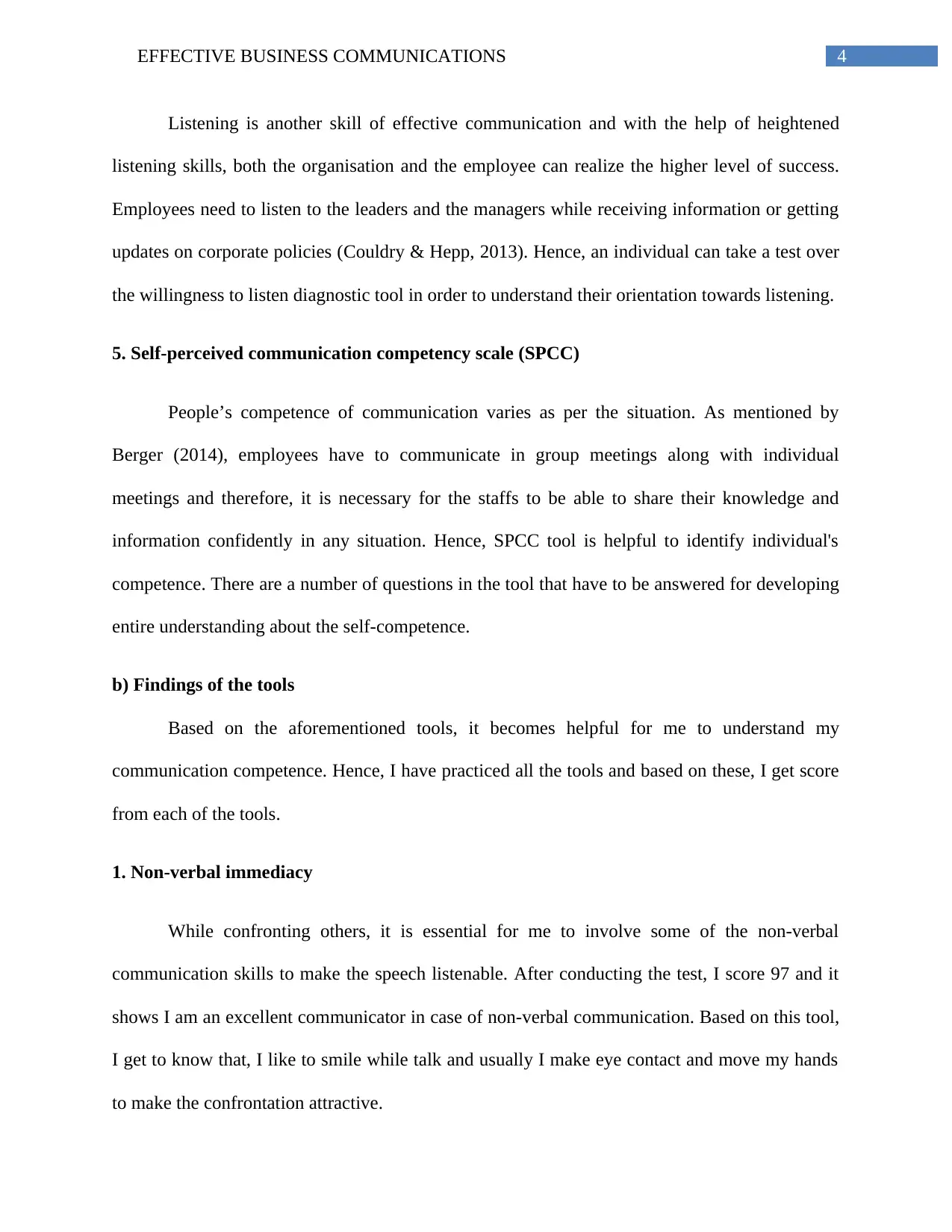
4EFFECTIVE BUSINESS COMMUNICATIONS
Listening is another skill of effective communication and with the help of heightened
listening skills, both the organisation and the employee can realize the higher level of success.
Employees need to listen to the leaders and the managers while receiving information or getting
updates on corporate policies (Couldry & Hepp, 2013). Hence, an individual can take a test over
the willingness to listen diagnostic tool in order to understand their orientation towards listening.
5. Self-perceived communication competency scale (SPCC)
People’s competence of communication varies as per the situation. As mentioned by
Berger (2014), employees have to communicate in group meetings along with individual
meetings and therefore, it is necessary for the staffs to be able to share their knowledge and
information confidently in any situation. Hence, SPCC tool is helpful to identify individual's
competence. There are a number of questions in the tool that have to be answered for developing
entire understanding about the self-competence.
b) Findings of the tools
Based on the aforementioned tools, it becomes helpful for me to understand my
communication competence. Hence, I have practiced all the tools and based on these, I get score
from each of the tools.
1. Non-verbal immediacy
While confronting others, it is essential for me to involve some of the non-verbal
communication skills to make the speech listenable. After conducting the test, I score 97 and it
shows I am an excellent communicator in case of non-verbal communication. Based on this tool,
I get to know that, I like to smile while talk and usually I make eye contact and move my hands
to make the confrontation attractive.
Listening is another skill of effective communication and with the help of heightened
listening skills, both the organisation and the employee can realize the higher level of success.
Employees need to listen to the leaders and the managers while receiving information or getting
updates on corporate policies (Couldry & Hepp, 2013). Hence, an individual can take a test over
the willingness to listen diagnostic tool in order to understand their orientation towards listening.
5. Self-perceived communication competency scale (SPCC)
People’s competence of communication varies as per the situation. As mentioned by
Berger (2014), employees have to communicate in group meetings along with individual
meetings and therefore, it is necessary for the staffs to be able to share their knowledge and
information confidently in any situation. Hence, SPCC tool is helpful to identify individual's
competence. There are a number of questions in the tool that have to be answered for developing
entire understanding about the self-competence.
b) Findings of the tools
Based on the aforementioned tools, it becomes helpful for me to understand my
communication competence. Hence, I have practiced all the tools and based on these, I get score
from each of the tools.
1. Non-verbal immediacy
While confronting others, it is essential for me to involve some of the non-verbal
communication skills to make the speech listenable. After conducting the test, I score 97 and it
shows I am an excellent communicator in case of non-verbal communication. Based on this tool,
I get to know that, I like to smile while talk and usually I make eye contact and move my hands
to make the confrontation attractive.
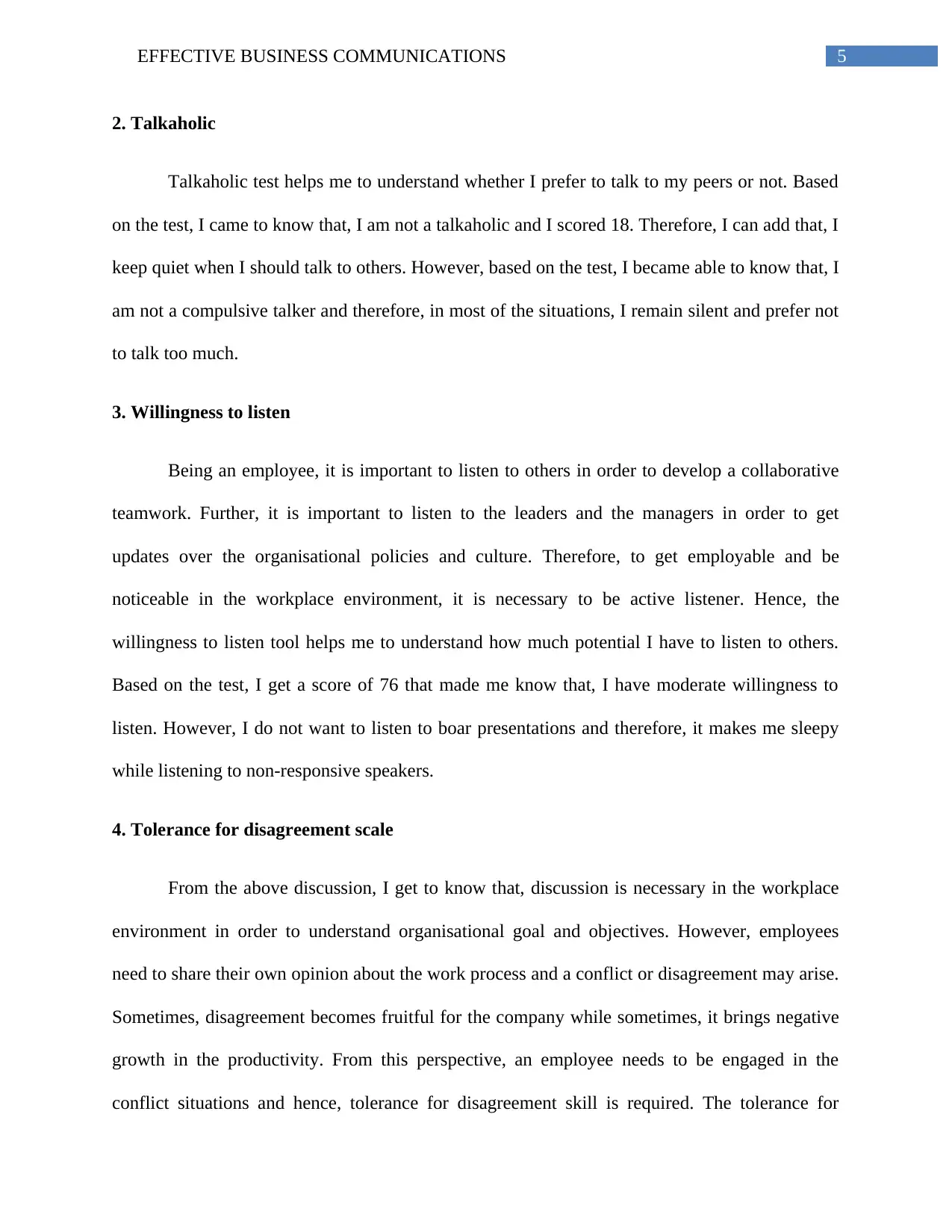
5EFFECTIVE BUSINESS COMMUNICATIONS
2. Talkaholic
Talkaholic test helps me to understand whether I prefer to talk to my peers or not. Based
on the test, I came to know that, I am not a talkaholic and I scored 18. Therefore, I can add that, I
keep quiet when I should talk to others. However, based on the test, I became able to know that, I
am not a compulsive talker and therefore, in most of the situations, I remain silent and prefer not
to talk too much.
3. Willingness to listen
Being an employee, it is important to listen to others in order to develop a collaborative
teamwork. Further, it is important to listen to the leaders and the managers in order to get
updates over the organisational policies and culture. Therefore, to get employable and be
noticeable in the workplace environment, it is necessary to be active listener. Hence, the
willingness to listen tool helps me to understand how much potential I have to listen to others.
Based on the test, I get a score of 76 that made me know that, I have moderate willingness to
listen. However, I do not want to listen to boar presentations and therefore, it makes me sleepy
while listening to non-responsive speakers.
4. Tolerance for disagreement scale
From the above discussion, I get to know that, discussion is necessary in the workplace
environment in order to understand organisational goal and objectives. However, employees
need to share their own opinion about the work process and a conflict or disagreement may arise.
Sometimes, disagreement becomes fruitful for the company while sometimes, it brings negative
growth in the productivity. From this perspective, an employee needs to be engaged in the
conflict situations and hence, tolerance for disagreement skill is required. The tolerance for
2. Talkaholic
Talkaholic test helps me to understand whether I prefer to talk to my peers or not. Based
on the test, I came to know that, I am not a talkaholic and I scored 18. Therefore, I can add that, I
keep quiet when I should talk to others. However, based on the test, I became able to know that, I
am not a compulsive talker and therefore, in most of the situations, I remain silent and prefer not
to talk too much.
3. Willingness to listen
Being an employee, it is important to listen to others in order to develop a collaborative
teamwork. Further, it is important to listen to the leaders and the managers in order to get
updates over the organisational policies and culture. Therefore, to get employable and be
noticeable in the workplace environment, it is necessary to be active listener. Hence, the
willingness to listen tool helps me to understand how much potential I have to listen to others.
Based on the test, I get a score of 76 that made me know that, I have moderate willingness to
listen. However, I do not want to listen to boar presentations and therefore, it makes me sleepy
while listening to non-responsive speakers.
4. Tolerance for disagreement scale
From the above discussion, I get to know that, discussion is necessary in the workplace
environment in order to understand organisational goal and objectives. However, employees
need to share their own opinion about the work process and a conflict or disagreement may arise.
Sometimes, disagreement becomes fruitful for the company while sometimes, it brings negative
growth in the productivity. From this perspective, an employee needs to be engaged in the
conflict situations and hence, tolerance for disagreement skill is required. The tolerance for
⊘ This is a preview!⊘
Do you want full access?
Subscribe today to unlock all pages.

Trusted by 1+ million students worldwide
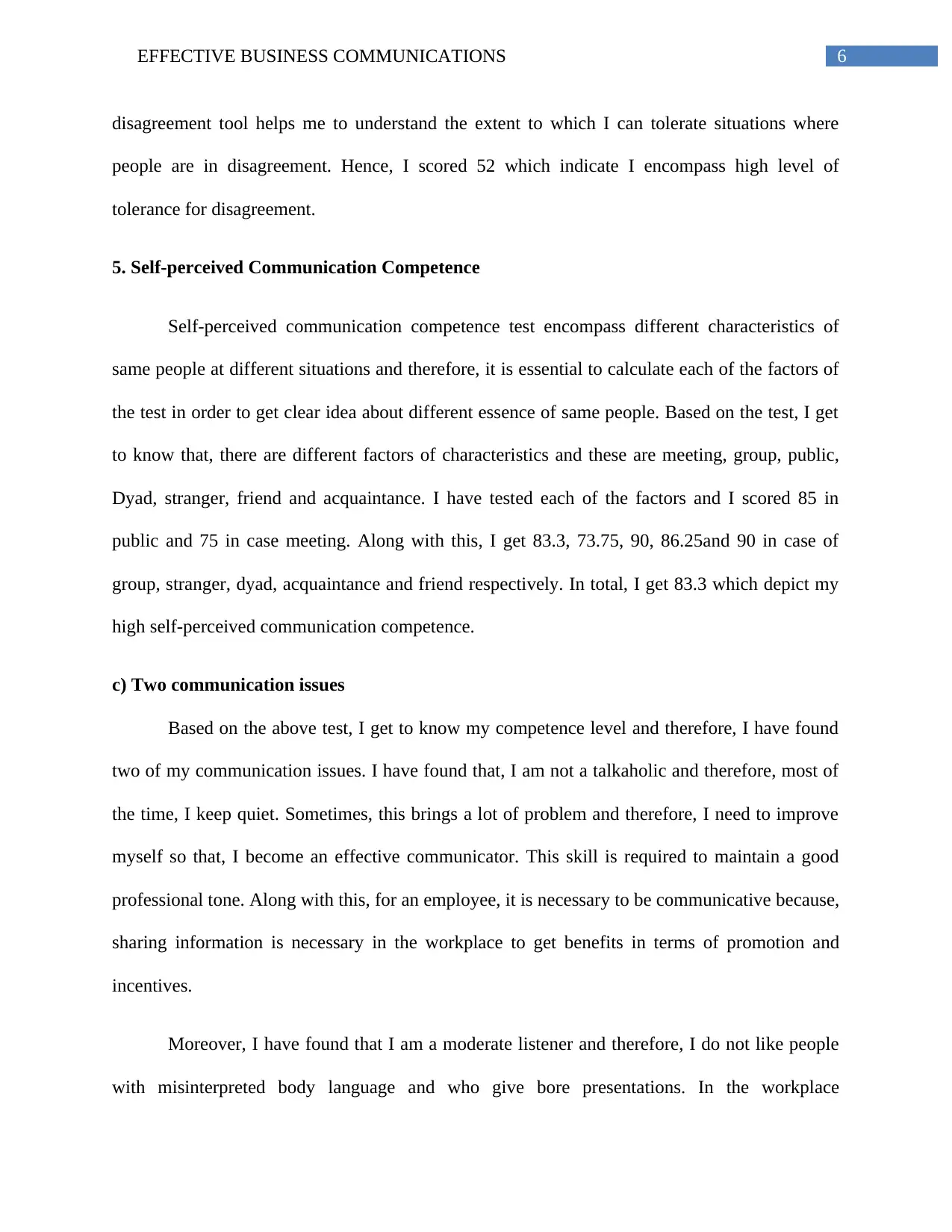
6EFFECTIVE BUSINESS COMMUNICATIONS
disagreement tool helps me to understand the extent to which I can tolerate situations where
people are in disagreement. Hence, I scored 52 which indicate I encompass high level of
tolerance for disagreement.
5. Self-perceived Communication Competence
Self-perceived communication competence test encompass different characteristics of
same people at different situations and therefore, it is essential to calculate each of the factors of
the test in order to get clear idea about different essence of same people. Based on the test, I get
to know that, there are different factors of characteristics and these are meeting, group, public,
Dyad, stranger, friend and acquaintance. I have tested each of the factors and I scored 85 in
public and 75 in case meeting. Along with this, I get 83.3, 73.75, 90, 86.25and 90 in case of
group, stranger, dyad, acquaintance and friend respectively. In total, I get 83.3 which depict my
high self-perceived communication competence.
c) Two communication issues
Based on the above test, I get to know my competence level and therefore, I have found
two of my communication issues. I have found that, I am not a talkaholic and therefore, most of
the time, I keep quiet. Sometimes, this brings a lot of problem and therefore, I need to improve
myself so that, I become an effective communicator. This skill is required to maintain a good
professional tone. Along with this, for an employee, it is necessary to be communicative because,
sharing information is necessary in the workplace to get benefits in terms of promotion and
incentives.
Moreover, I have found that I am a moderate listener and therefore, I do not like people
with misinterpreted body language and who give bore presentations. In the workplace
disagreement tool helps me to understand the extent to which I can tolerate situations where
people are in disagreement. Hence, I scored 52 which indicate I encompass high level of
tolerance for disagreement.
5. Self-perceived Communication Competence
Self-perceived communication competence test encompass different characteristics of
same people at different situations and therefore, it is essential to calculate each of the factors of
the test in order to get clear idea about different essence of same people. Based on the test, I get
to know that, there are different factors of characteristics and these are meeting, group, public,
Dyad, stranger, friend and acquaintance. I have tested each of the factors and I scored 85 in
public and 75 in case meeting. Along with this, I get 83.3, 73.75, 90, 86.25and 90 in case of
group, stranger, dyad, acquaintance and friend respectively. In total, I get 83.3 which depict my
high self-perceived communication competence.
c) Two communication issues
Based on the above test, I get to know my competence level and therefore, I have found
two of my communication issues. I have found that, I am not a talkaholic and therefore, most of
the time, I keep quiet. Sometimes, this brings a lot of problem and therefore, I need to improve
myself so that, I become an effective communicator. This skill is required to maintain a good
professional tone. Along with this, for an employee, it is necessary to be communicative because,
sharing information is necessary in the workplace to get benefits in terms of promotion and
incentives.
Moreover, I have found that I am a moderate listener and therefore, I do not like people
with misinterpreted body language and who give bore presentations. In the workplace
Paraphrase This Document
Need a fresh take? Get an instant paraphrase of this document with our AI Paraphraser
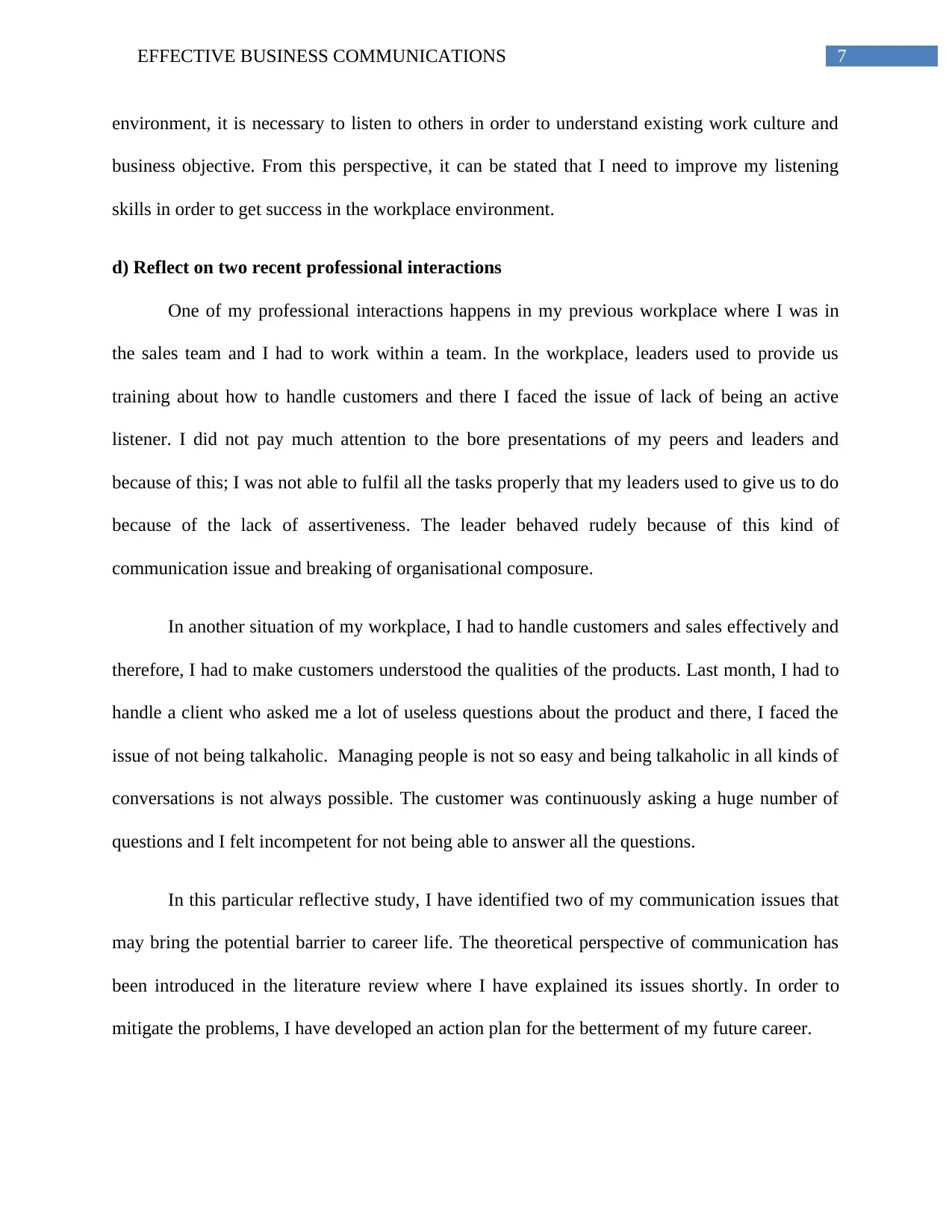
7EFFECTIVE BUSINESS COMMUNICATIONS
environment, it is necessary to listen to others in order to understand existing work culture and
business objective. From this perspective, it can be stated that I need to improve my listening
skills in order to get success in the workplace environment.
d) Reflect on two recent professional interactions
One of my professional interactions happens in my previous workplace where I was in
the sales team and I had to work within a team. In the workplace, leaders used to provide us
training about how to handle customers and there I faced the issue of lack of being an active
listener. I did not pay much attention to the bore presentations of my peers and leaders and
because of this; I was not able to fulfil all the tasks properly that my leaders used to give us to do
because of the lack of assertiveness. The leader behaved rudely because of this kind of
communication issue and breaking of organisational composure.
In another situation of my workplace, I had to handle customers and sales effectively and
therefore, I had to make customers understood the qualities of the products. Last month, I had to
handle a client who asked me a lot of useless questions about the product and there, I faced the
issue of not being talkaholic. Managing people is not so easy and being talkaholic in all kinds of
conversations is not always possible. The customer was continuously asking a huge number of
questions and I felt incompetent for not being able to answer all the questions.
In this particular reflective study, I have identified two of my communication issues that
may bring the potential barrier to career life. The theoretical perspective of communication has
been introduced in the literature review where I have explained its issues shortly. In order to
mitigate the problems, I have developed an action plan for the betterment of my future career.
environment, it is necessary to listen to others in order to understand existing work culture and
business objective. From this perspective, it can be stated that I need to improve my listening
skills in order to get success in the workplace environment.
d) Reflect on two recent professional interactions
One of my professional interactions happens in my previous workplace where I was in
the sales team and I had to work within a team. In the workplace, leaders used to provide us
training about how to handle customers and there I faced the issue of lack of being an active
listener. I did not pay much attention to the bore presentations of my peers and leaders and
because of this; I was not able to fulfil all the tasks properly that my leaders used to give us to do
because of the lack of assertiveness. The leader behaved rudely because of this kind of
communication issue and breaking of organisational composure.
In another situation of my workplace, I had to handle customers and sales effectively and
therefore, I had to make customers understood the qualities of the products. Last month, I had to
handle a client who asked me a lot of useless questions about the product and there, I faced the
issue of not being talkaholic. Managing people is not so easy and being talkaholic in all kinds of
conversations is not always possible. The customer was continuously asking a huge number of
questions and I felt incompetent for not being able to answer all the questions.
In this particular reflective study, I have identified two of my communication issues that
may bring the potential barrier to career life. The theoretical perspective of communication has
been introduced in the literature review where I have explained its issues shortly. In order to
mitigate the problems, I have developed an action plan for the betterment of my future career.
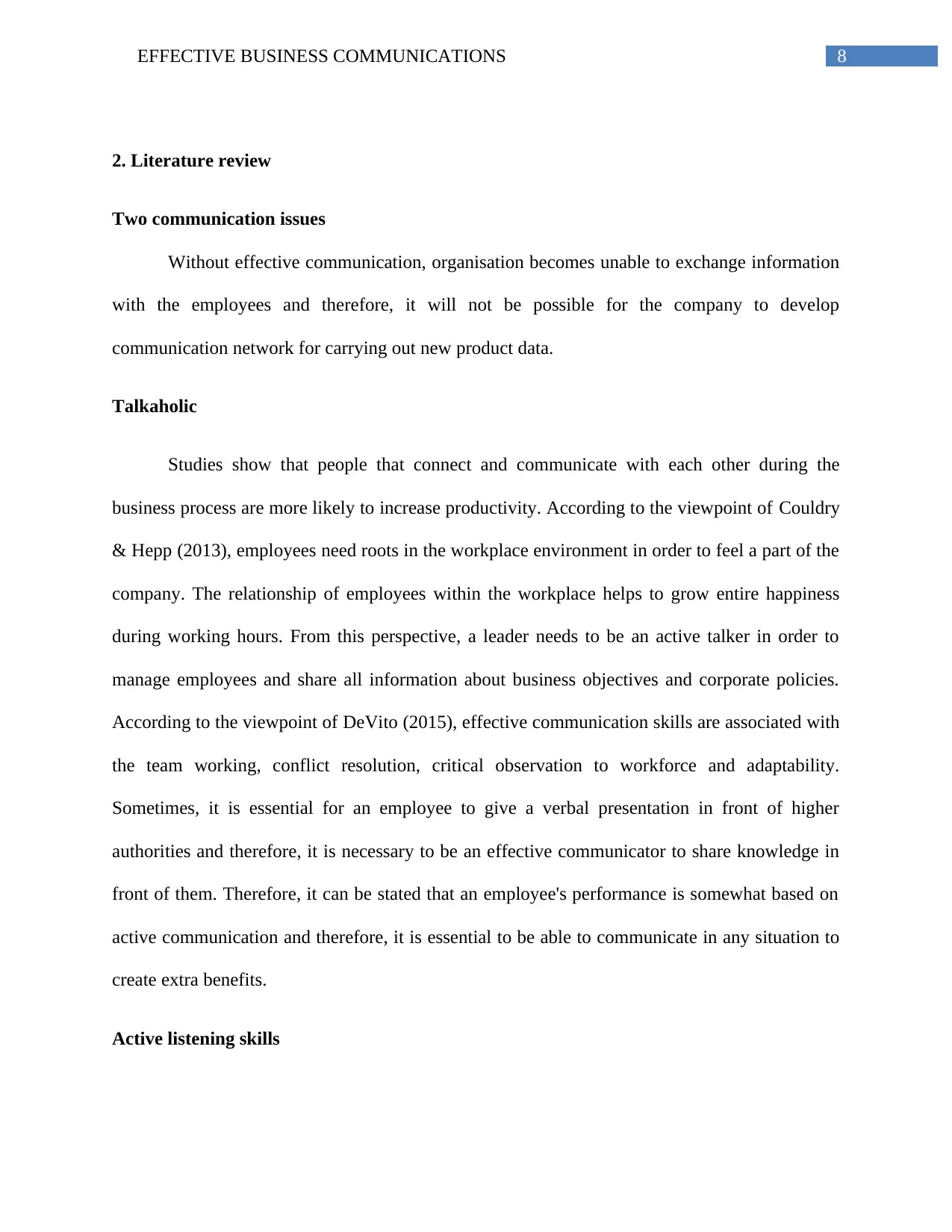
8EFFECTIVE BUSINESS COMMUNICATIONS
2. Literature review
Two communication issues
Without effective communication, organisation becomes unable to exchange information
with the employees and therefore, it will not be possible for the company to develop
communication network for carrying out new product data.
Talkaholic
Studies show that people that connect and communicate with each other during the
business process are more likely to increase productivity. According to the viewpoint of Couldry
& Hepp (2013), employees need roots in the workplace environment in order to feel a part of the
company. The relationship of employees within the workplace helps to grow entire happiness
during working hours. From this perspective, a leader needs to be an active talker in order to
manage employees and share all information about business objectives and corporate policies.
According to the viewpoint of DeVito (2015), effective communication skills are associated with
the team working, conflict resolution, critical observation to workforce and adaptability.
Sometimes, it is essential for an employee to give a verbal presentation in front of higher
authorities and therefore, it is necessary to be an effective communicator to share knowledge in
front of them. Therefore, it can be stated that an employee's performance is somewhat based on
active communication and therefore, it is essential to be able to communicate in any situation to
create extra benefits.
Active listening skills
2. Literature review
Two communication issues
Without effective communication, organisation becomes unable to exchange information
with the employees and therefore, it will not be possible for the company to develop
communication network for carrying out new product data.
Talkaholic
Studies show that people that connect and communicate with each other during the
business process are more likely to increase productivity. According to the viewpoint of Couldry
& Hepp (2013), employees need roots in the workplace environment in order to feel a part of the
company. The relationship of employees within the workplace helps to grow entire happiness
during working hours. From this perspective, a leader needs to be an active talker in order to
manage employees and share all information about business objectives and corporate policies.
According to the viewpoint of DeVito (2015), effective communication skills are associated with
the team working, conflict resolution, critical observation to workforce and adaptability.
Sometimes, it is essential for an employee to give a verbal presentation in front of higher
authorities and therefore, it is necessary to be an effective communicator to share knowledge in
front of them. Therefore, it can be stated that an employee's performance is somewhat based on
active communication and therefore, it is essential to be able to communicate in any situation to
create extra benefits.
Active listening skills
⊘ This is a preview!⊘
Do you want full access?
Subscribe today to unlock all pages.

Trusted by 1+ million students worldwide
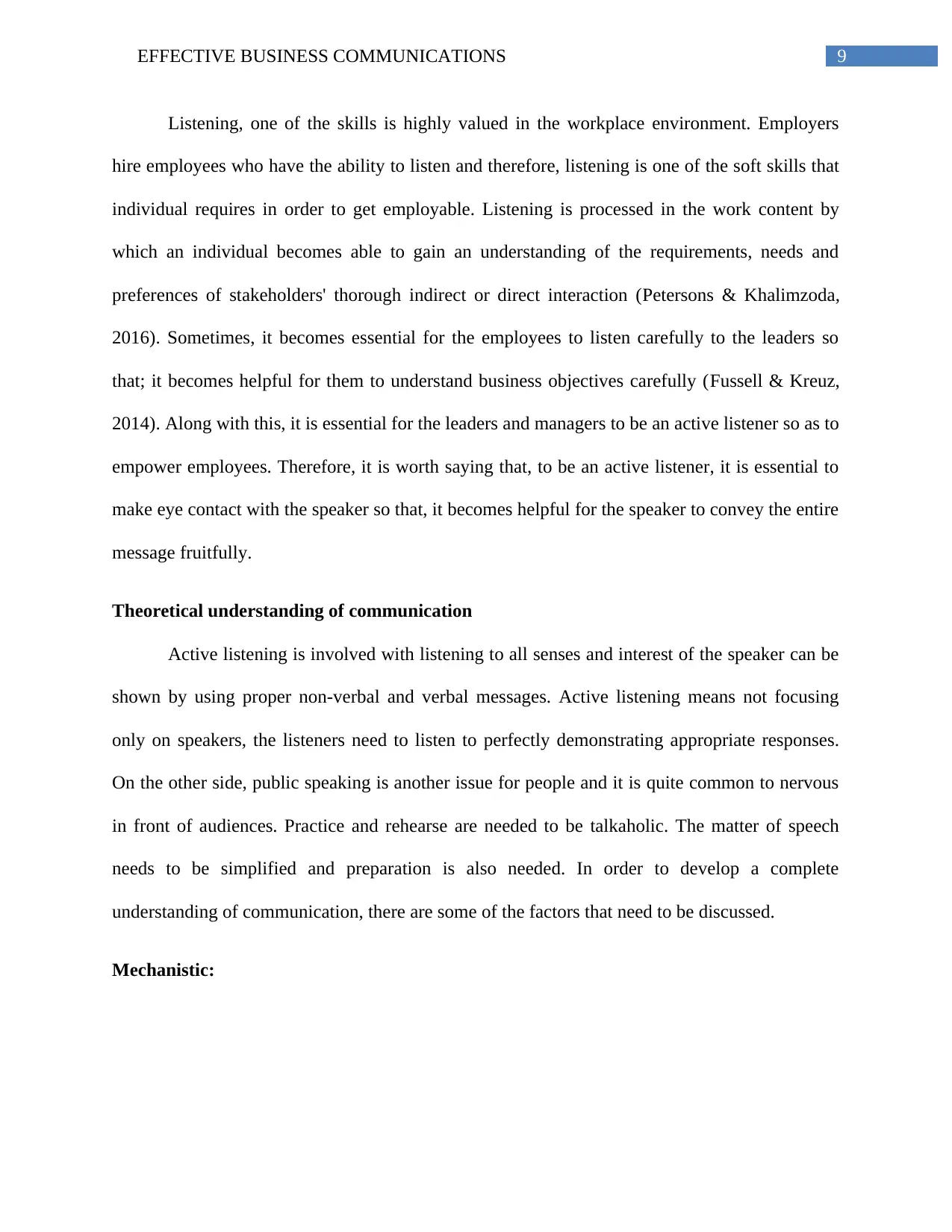
9EFFECTIVE BUSINESS COMMUNICATIONS
Listening, one of the skills is highly valued in the workplace environment. Employers
hire employees who have the ability to listen and therefore, listening is one of the soft skills that
individual requires in order to get employable. Listening is processed in the work content by
which an individual becomes able to gain an understanding of the requirements, needs and
preferences of stakeholders' thorough indirect or direct interaction (Petersons & Khalimzoda,
2016). Sometimes, it becomes essential for the employees to listen carefully to the leaders so
that; it becomes helpful for them to understand business objectives carefully (Fussell & Kreuz,
2014). Along with this, it is essential for the leaders and managers to be an active listener so as to
empower employees. Therefore, it is worth saying that, to be an active listener, it is essential to
make eye contact with the speaker so that, it becomes helpful for the speaker to convey the entire
message fruitfully.
Theoretical understanding of communication
Active listening is involved with listening to all senses and interest of the speaker can be
shown by using proper non-verbal and verbal messages. Active listening means not focusing
only on speakers, the listeners need to listen to perfectly demonstrating appropriate responses.
On the other side, public speaking is another issue for people and it is quite common to nervous
in front of audiences. Practice and rehearse are needed to be talkaholic. The matter of speech
needs to be simplified and preparation is also needed. In order to develop a complete
understanding of communication, there are some of the factors that need to be discussed.
Mechanistic:
Listening, one of the skills is highly valued in the workplace environment. Employers
hire employees who have the ability to listen and therefore, listening is one of the soft skills that
individual requires in order to get employable. Listening is processed in the work content by
which an individual becomes able to gain an understanding of the requirements, needs and
preferences of stakeholders' thorough indirect or direct interaction (Petersons & Khalimzoda,
2016). Sometimes, it becomes essential for the employees to listen carefully to the leaders so
that; it becomes helpful for them to understand business objectives carefully (Fussell & Kreuz,
2014). Along with this, it is essential for the leaders and managers to be an active listener so as to
empower employees. Therefore, it is worth saying that, to be an active listener, it is essential to
make eye contact with the speaker so that, it becomes helpful for the speaker to convey the entire
message fruitfully.
Theoretical understanding of communication
Active listening is involved with listening to all senses and interest of the speaker can be
shown by using proper non-verbal and verbal messages. Active listening means not focusing
only on speakers, the listeners need to listen to perfectly demonstrating appropriate responses.
On the other side, public speaking is another issue for people and it is quite common to nervous
in front of audiences. Practice and rehearse are needed to be talkaholic. The matter of speech
needs to be simplified and preparation is also needed. In order to develop a complete
understanding of communication, there are some of the factors that need to be discussed.
Mechanistic:
Paraphrase This Document
Need a fresh take? Get an instant paraphrase of this document with our AI Paraphraser
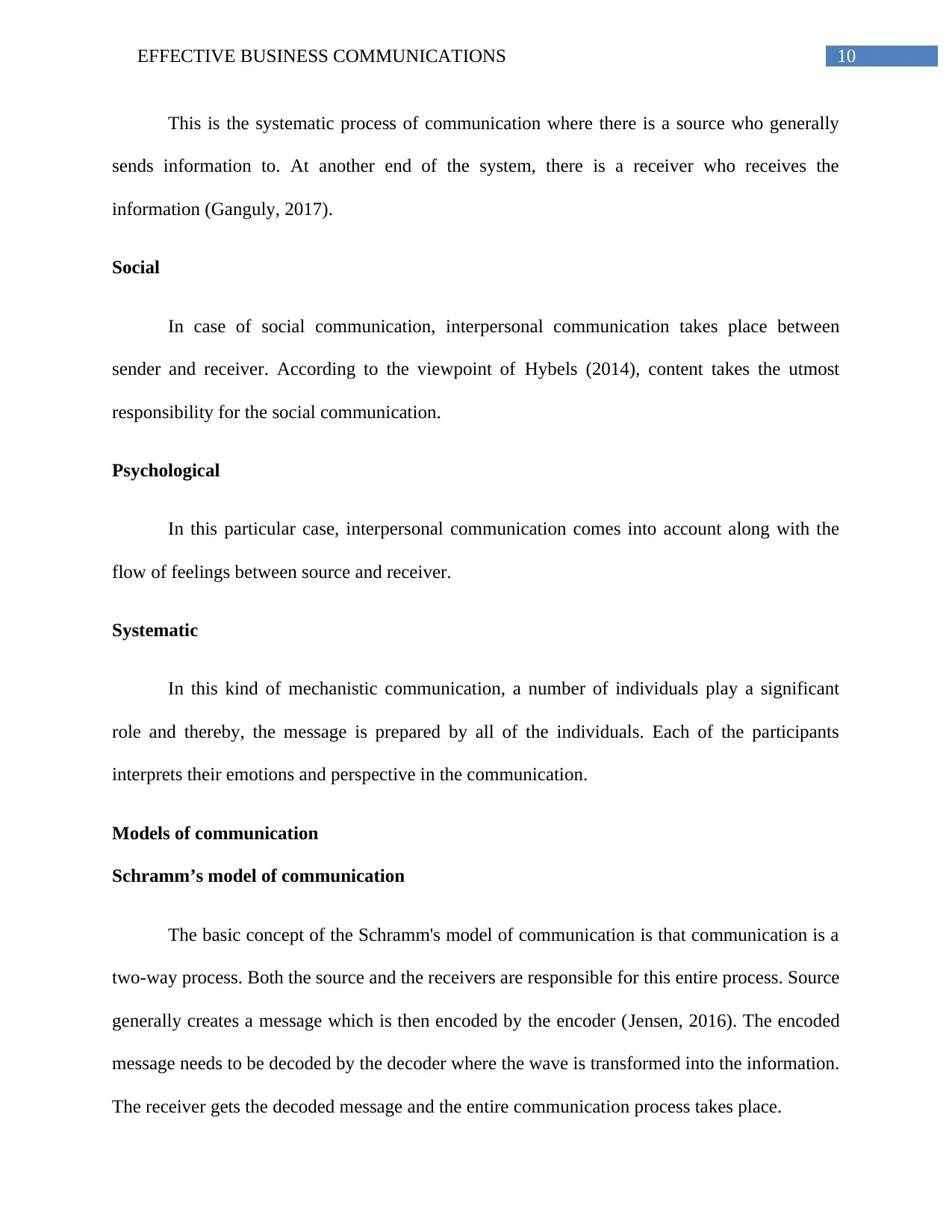
10EFFECTIVE BUSINESS COMMUNICATIONS
This is the systematic process of communication where there is a source who generally
sends information to. At another end of the system, there is a receiver who receives the
information (Ganguly, 2017).
Social
In case of social communication, interpersonal communication takes place between
sender and receiver. According to the viewpoint of Hybels (2014), content takes the utmost
responsibility for the social communication.
Psychological
In this particular case, interpersonal communication comes into account along with the
flow of feelings between source and receiver.
Systematic
In this kind of mechanistic communication, a number of individuals play a significant
role and thereby, the message is prepared by all of the individuals. Each of the participants
interprets their emotions and perspective in the communication.
Models of communication
Schramm’s model of communication
The basic concept of the Schramm's model of communication is that communication is a
two-way process. Both the source and the receivers are responsible for this entire process. Source
generally creates a message which is then encoded by the encoder (Jensen, 2016). The encoded
message needs to be decoded by the decoder where the wave is transformed into the information.
The receiver gets the decoded message and the entire communication process takes place.
This is the systematic process of communication where there is a source who generally
sends information to. At another end of the system, there is a receiver who receives the
information (Ganguly, 2017).
Social
In case of social communication, interpersonal communication takes place between
sender and receiver. According to the viewpoint of Hybels (2014), content takes the utmost
responsibility for the social communication.
Psychological
In this particular case, interpersonal communication comes into account along with the
flow of feelings between source and receiver.
Systematic
In this kind of mechanistic communication, a number of individuals play a significant
role and thereby, the message is prepared by all of the individuals. Each of the participants
interprets their emotions and perspective in the communication.
Models of communication
Schramm’s model of communication
The basic concept of the Schramm's model of communication is that communication is a
two-way process. Both the source and the receivers are responsible for this entire process. Source
generally creates a message which is then encoded by the encoder (Jensen, 2016). The encoded
message needs to be decoded by the decoder where the wave is transformed into the information.
The receiver gets the decoded message and the entire communication process takes place.
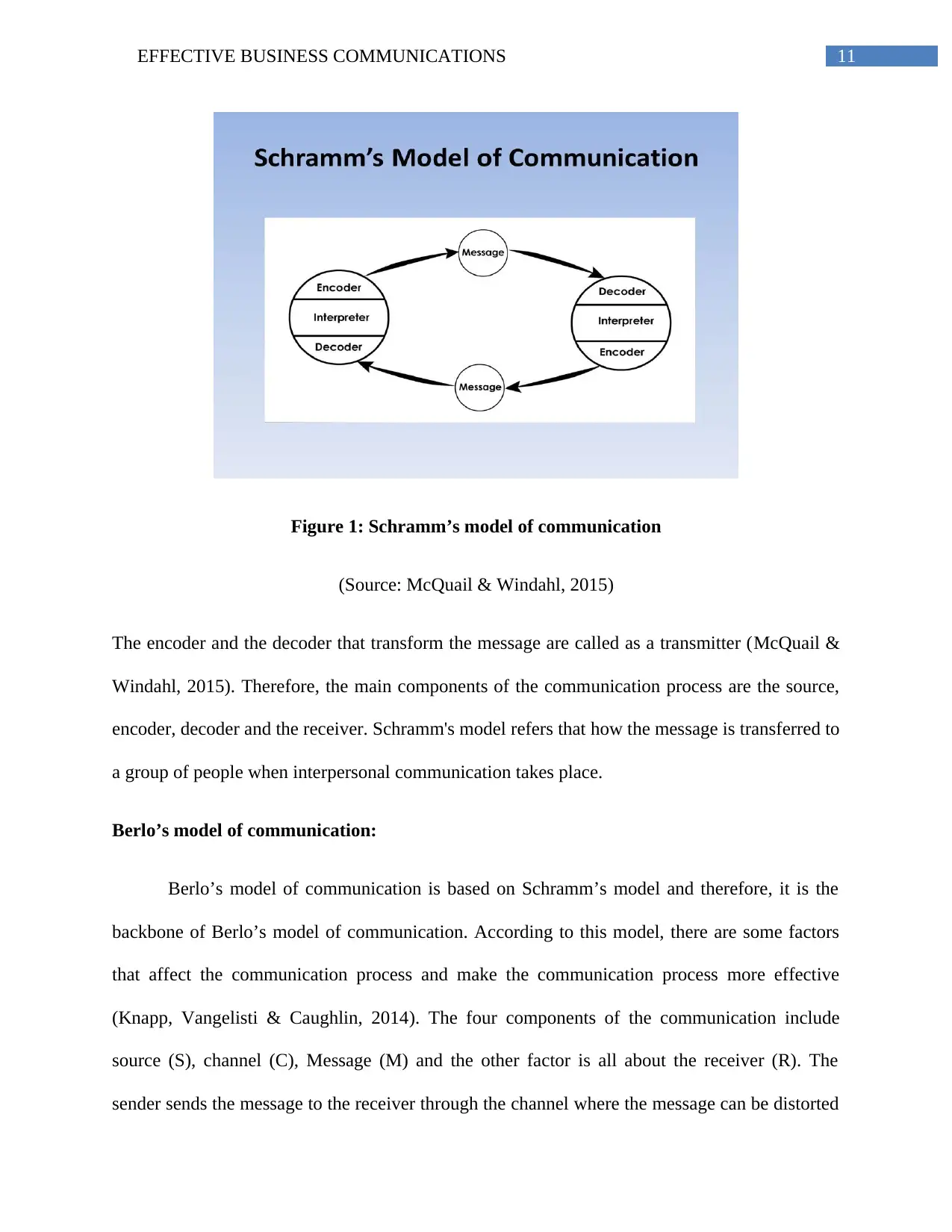
11EFFECTIVE BUSINESS COMMUNICATIONS
Figure 1: Schramm’s model of communication
(Source: McQuail & Windahl, 2015)
The encoder and the decoder that transform the message are called as a transmitter (McQuail &
Windahl, 2015). Therefore, the main components of the communication process are the source,
encoder, decoder and the receiver. Schramm's model refers that how the message is transferred to
a group of people when interpersonal communication takes place.
Berlo’s model of communication:
Berlo’s model of communication is based on Schramm’s model and therefore, it is the
backbone of Berlo’s model of communication. According to this model, there are some factors
that affect the communication process and make the communication process more effective
(Knapp, Vangelisti & Caughlin, 2014). The four components of the communication include
source (S), channel (C), Message (M) and the other factor is all about the receiver (R). The
sender sends the message to the receiver through the channel where the message can be distorted
Figure 1: Schramm’s model of communication
(Source: McQuail & Windahl, 2015)
The encoder and the decoder that transform the message are called as a transmitter (McQuail &
Windahl, 2015). Therefore, the main components of the communication process are the source,
encoder, decoder and the receiver. Schramm's model refers that how the message is transferred to
a group of people when interpersonal communication takes place.
Berlo’s model of communication:
Berlo’s model of communication is based on Schramm’s model and therefore, it is the
backbone of Berlo’s model of communication. According to this model, there are some factors
that affect the communication process and make the communication process more effective
(Knapp, Vangelisti & Caughlin, 2014). The four components of the communication include
source (S), channel (C), Message (M) and the other factor is all about the receiver (R). The
sender sends the message to the receiver through the channel where the message can be distorted
⊘ This is a preview!⊘
Do you want full access?
Subscribe today to unlock all pages.

Trusted by 1+ million students worldwide
1 out of 24
Related Documents
Your All-in-One AI-Powered Toolkit for Academic Success.
+13062052269
info@desklib.com
Available 24*7 on WhatsApp / Email
![[object Object]](/_next/static/media/star-bottom.7253800d.svg)
Unlock your academic potential
Copyright © 2020–2025 A2Z Services. All Rights Reserved. Developed and managed by ZUCOL.



